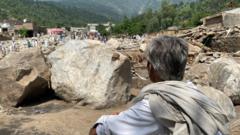Tragedy has struck northern Pakistan as relentless rains and flash floods have resulted in the deaths of at least 314 people, with 156 others injured. The picturesque village of Bishnoi faced an unimaginable disaster on August 15 when heavy rains transformed a peaceful morning into chaos. Residents were caught off guard as torrents of water, laden with boulders, devastated the community.
Rescue workers and residents are tirelessly clearing the debris, with many homes now unrecognizable under the rubble. “There is a house under every stone,” expressed local Israr Khan, who continues to search for survivors amid the destruction. The Buner district is particularly affected, suffering the highest fatalities in the region.
This monsoon season, which typically accounts for the majority of South Asia’s rainfall, has already claimed 650 lives across the region. In Pakistan, the total death toll has risen to 507 since the season began. Major areas, including Punjab and the capital Islamabad, have faced severe flooding, but the Khyber Pakhtunkhwa region has sustained the worst impacts due to its fragile geography.
Experts indicate that melting glaciers attributed to global warming are exacerbating the risk of landslides and floods. With additional rainfall expected in the coming days, authorities have declared several areas as disaster zones. Amidst this turmoil, reports highlight heroic actions, such as a school principal in the Swat Valley who successfully evacuated 900 students just before catastrophe struck.
As community and relief organizations mobilize to provide aid, the search for missing individuals tragically continues. The people of Pakistan are banding together in their efforts to recover from this devastating event, demonstrating resilience even in the face of heartbreaking loss.



















